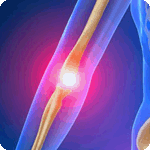Golfer's Elbow
Golfer's Elbow Causes
As mentioned above, golfer's elbow is usually caused by overuse. Repetitive elbow motion at work or during sports are leading causes of medial epicondylitis. Some examples of activities that may cause golfer's elbow include golf, tennis, carpentry, or painting. Other damage to the tendon, such as from impact to the elbow, may also cause golfer's elbow.
Golfer's Elbow Symptoms
Pain from golfer's elbow is usually experienced on the elbow joint at the inside of the arm (where your elbow creases). Pain on the inside forearm is also common. If you were to rest your arm on a table, this is the area that is directly touching the surface. Patients may experience additional pain when carrying out certain actions, such as gripping an object, turning a doorknob, performing a swinging motion with the arm, or even picking something up. Other symptoms include stiffness, pain when making a fist, and weakness in the hands and wrists. In some cases, numbness or tingling may be present in the fingers.
Golfer's Elbow Treatment
As with any injury, your doctor will be the best source of advice on the appropriate treatment method for your situation. Immediate pain management for golfer's elbow often includes resting and icing the area. (Check out the Aircast Elbow Cryo/Cuff with Cooler.) Anti-inflammatory medications such as ibuprofen and aspirin may also be used to help manage pain.
After your elbow has had time to recover, then your doctor may recommend physical therapy to help strengthen and stretch the muscles around the elbow joint. This may include exercises such as squeezing a tennis ball, wrist curls and reverse wrist curls. Strengthening the forearm muscles may help prevent future irritation to the tendons in your elbow. Sometimes training in the proper techniques for certain activities may also help reduce pain from medial epicondylitis, such as learning how to do a proper golf swing.
Wearing a golfer's elbow brace may help reduce strain on the elbow. They minimize the load on your elbow when you're performing various activities. Your doctor may also suggest that you decrease the amount of time you play sports or modify the types of activities you're doing to reduce strain.
Typically, it can take weeks or even months for golfer's elbow to heal. However, the condition can easily come back if you continue to place too much stress on your elbows. If your pain continues after conventional golfer's elbow treatment, your doctor may recommend steroid injections or even surgery.
SUPPORT & PROTECTION FOR GOLFER'S ELBOW
View all Braces and Supports for Golfer's Elbow
-
 $36.99On Sale 0% Off Save $0.00(17) ReviewsExperience targeted compression and support with the Aircast Pneumatic Armband. Adjustable air cells reduce pain and swelling for effective injury recovery. Ideal for tendonitis and elbow strains—stay comfortable and heal faster every day.
$36.99On Sale 0% Off Save $0.00(17) ReviewsExperience targeted compression and support with the Aircast Pneumatic Armband. Adjustable air cells reduce pain and swelling for effective injury recovery. Ideal for tendonitis and elbow strains—stay comfortable and heal faster every day.The Pneumatic Armband can be used to treat or prevent the following arm injuries:
- Tennis Instability
- Golfer's Elbow
- Tendonitis
- Mild Strains
-
 $35.99On Sale 0% Off Save $0.00(1) ReviewTarget pain and support your elbow with the DonJoy Performance Webtech Elbow Strap. Adjustable strap design relieves tendonitis and reduces strain during activity. Lightweight, durable, and perfect for athletes seeking fast relief and lasting comfort.
$35.99On Sale 0% Off Save $0.00(1) ReviewTarget pain and support your elbow with the DonJoy Performance Webtech Elbow Strap. Adjustable strap design relieves tendonitis and reduces strain during activity. Lightweight, durable, and perfect for athletes seeking fast relief and lasting comfort.The Performance Webtech Elbow Strap can be used to treat or prevent the following elbow injuries:
- Tennis Elbow
- Golfer's Elbow
- Tendonitis
- Overuse Injury
- Overuse Injury
- Mid-Level Support
- Pain Management
-
 Special Price $9.99 Regular Price $11.99On Sale 17% Off Save $2.00Target tennis and golf elbow pain with the DonJoy Advantage Elbow Strap. Adjustable, durable support reduces strain and enhances comfort during play. Perfect for athletes seeking fast relief and improved performance on the court or course.
Special Price $9.99 Regular Price $11.99On Sale 17% Off Save $2.00Target tennis and golf elbow pain with the DonJoy Advantage Elbow Strap. Adjustable, durable support reduces strain and enhances comfort during play. Perfect for athletes seeking fast relief and improved performance on the court or course.





 Golfer's elbow, also known as medial epicondylitis, is an overuse injury that occurs in the elbow. As its name suggests, it is very common in people who play golf. However, any type of repetitive elbow activity can cause medial epicondylitis. Golfer's elbow occurs when the tendons that attach your forearm muscles to the inside of the bone at your elbow become worn down and inflamed. Individuals with golfer's elbow are also at risk for
Golfer's elbow, also known as medial epicondylitis, is an overuse injury that occurs in the elbow. As its name suggests, it is very common in people who play golf. However, any type of repetitive elbow activity can cause medial epicondylitis. Golfer's elbow occurs when the tendons that attach your forearm muscles to the inside of the bone at your elbow become worn down and inflamed. Individuals with golfer's elbow are also at risk for 




